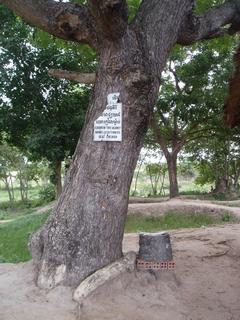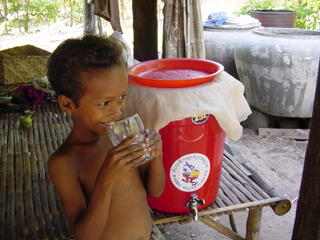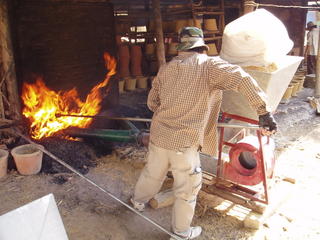Difficult Topics
I departed Cambodia on Monday at 2:30pm local time. Forty-two hours, one misbooked flight, and some delayed luggage later, I arrived home Tuesday at 7pm. I’ll be staying at my parents’ house until UofT Meds orientation begins next week. Back on this side of the world, I can be reached at 416-449-3228. I’ll post a final update about the vegetable transport project and contact info about my new place next week.
There are two topics that are central to understanding life in Cambodia about which I still haven’t written. I didn’t want to try and tackle them until I felt I could do them proper justice. Though I’m still not sure that I can, I’ve tried my best to do so below.
Genocide
There is one aspect of Cambodian society that makes it almost unique on Earth. Here every native over the age of twenty-six is either a genocide survivor or a perpetrator of genocide. Many are both at once. Consider the respect with which Holocaust survivors are treated in the Jewish community and the absolute contempt reserved for perpetrators of the Nazi genocide. Here both groups live side by side. They have to. They have no choice.
I have a friend in Phnom Penh, an old man with whom I drink coffee or soda every couple of weeks. He worked as an official in the Lon Nol government until the fall of Phnom Penh in 1975. He was one of the few lucky ones. Displaced anonymously far into the northwest, no one around him knew his history. He managed to hide his education. When the Khmer Rouge asked him to read, he feigned ignorance. His younger brother was not so lucky. A young engineer, he was obviously just a little too bright. It got him killed.
A short glance at most survivors’ stories reveals the twisted combination of a boring day-to-day existence in which the only constant is suffering and exceptional cruelty: a boy’s mother led off to be killed for daring to warn an old woman not to stumble, families forced to watch as their loved ones were summarily gutted for stealing food, mass starvation, cannibalism, and death.
Between 1975 and 1979, Cambodian life rolled onwards between these shocks. Mr. Lang, the oldest employee at IDE, told me over cobs of corn one day about how he had grown fat during the Khmer Rouge regime. He was lucky enough to be in charge of cooking for his group. When rice wasn’t available, corn was distributed. He took advantage of the situation by snatching bites while cooking. Another friend once told me over a bowl of soup about how even after the Khmer Rouge regime, fish was so scarce that her family used to have tiny sword-fights for it with their utensils as they reached into their shared soup bowl.
In a blaze of paranoia that consumed not only peasants, former officers, and intellectuals, but even members of the Khmer Rouge’s elite centre, those accused of spying were brought to Tuol Sleng prison in Phnom Penh. There they were tortured for several months, forced to write detailed confessions of their role in a global conspiracy that by the end included the CIA, KGB, and the Viet Cong, transported to the Chinese cemetery at Choeung Ek, told to dig a pit, and then struck at the base of the head with a metal bar, their throats later sawed off with palm fronds. Infant children of those brought to the prison were treated no better. They were seized by the legs and hurled headfirst against a tree. Sometimes they were thrown into the air to be shot or to land on an upraised bayonet. Those named in the confessions soon replaced their unlucky and unwilling accusers at the prison. Of the tens of thousands brought to Tuol Sleng prison, only seven were still alive when the Vietnamese arrived in 1979.
How do Cambodians put such insanity behind them? How could any victim live alongside the perpetrator of such crimes? The answer itself is very Cambodian. With a unique flair for avoiding unpleasantness, the perpetrators have learned that it’s far easier to blame a mysterious superior than to accept responsibility.
Here, no one is responsible. Former Khmer Rouge cadres will all swear that though they saw their superiors commit atrocities, they themselves were never involved. Usually, those superiors have mysteriously disappeared, leaving nothing behind but their revolutionary nicknames and a string of atrocities. Victims, realizing that revenge is impossible, generally wait for Karma to settle the matter in the next life.
This philosophy can be taken to the highest extremes. The man in charge of leading the transports from Tuol Sleng prison to the Killing Fields at Choeung Ek has been recorded on video crying out for justice against the perpetrators of the genocide:
“The victims used to say to me, ‘We do not want to go on the truck. You will kill us.’ ‘No’, I reasuured them, ‘we are taking you to a new facility.’ Their arms were tied behind them. They would stand or kneel by the pit. Someone would strike them here, just below the head. Sometimes, Comrade Duć [Chief of Tuol Sleng Prison] would come and say to me, ‘Are you ready to kill?’ I would always answer ‘Yes brother.’ I knew that if I ever failed, I would be next. I did not enjoy the killing but when I had to do it, I would do nothing so big, I would just hit them as I had to do.’
Comrade Duć for his part was found about five years ago, working as a medical orderly with a Christian group. I have no doubt that if and when the Khmer Rouge tribunal begins, he will merrily tell of his role and blame his superiors too.
Eventually all of the blame shifts to the only man left, the one at the top, Pol Pot. Luckily for him and those blaming him for their own crimes, he died years ago, an old man in the jungles of the northwest. Here in Cambodia they never speak of the Khmer Rouge regime, only the Pol Pot period. It’s so much easier that way when so much of the population, including many of the highest-ranking government officials, amongst them the Prime Minister himself, are former Khmer Rouge.
This may go a long way to explaining why even now, after nearly three decades, the upcoming Khmer Rouge tribunal keeps encountering unexpected difficulties. The corruption of the judiciary aside, the government has repeatedly pleaded a lack of funds. The international community has by now offered to cover the bulk of the costs, leaving the Cambodian government to supply the final $11million.
Though they have recently found the means to support a $30 million loan towards the creation of a new phone company, of which there are already several operating in Cambodia, they still cannot spare even one third of this to fund the tribunal. Donations from private individuals are quietly being discouraged or refused, while the government continues to plead with foreign nations to foot the bill.
It’s a good strategy. Most donating countries are already fed up with the lack of will on the Cambodian side. They’re generally sick of being asked to pay more. The trial is thus delayed as long as possible, avoiding any unpleasantness for those who are still involved in politics. It’s a Cambodian solution to a Cambodian problem and it’s depressingly efficient.
Corruption
Every year, an NGO known as Transparency International publishes a list ranking corruption among the world’s governments. This year, Canada was ranked twelfth out of 146 countries. Bangladesh and Haiti were last. Cambodia wasn’t even ranked. I guess that some things are too big to be worth quantifying.
To put Cambodian corruption in perspective, I asked Mike during my farewell lunch to compare it to Bangladesh. He told me, “I’ve done no work in Bangladesh myself, but friends who have worked in both countries tell me that on average Cambodian businesses pay twice as much money in ‘corruption fees’ as do their Bangladeshi counterparts.”
The Canadian International Development Agency (CIDA), the government agency responsible for overseeing how our foreign aid budget is spent, recently named Cambodia to a short list of priority countries. This means that Cambodia will be eligible to receive far more money from our government. It’s a bit of a mixed blessing.
Currently Cambodian farmers can’t work for two-thirds of the year because of the alternating rain-driven cycles of deluge and drought. Properly planned large-scale irrigation could help to change that. Though Cambodia’s roads are fun for adventure tourist motorbikers to visit, you wouldn’t want to live with them.
Either of these problems would require a sizable investment to fix. A central government is needed to coordinate such large-scale projects. Funding is needed to start them. Unfortunately, simply handing that money to the Cambodian government is virtually a guarantee that it will be funding someone’s new villa, the well-paved private road leading to that villa, and the unnecessary Landrover to drive that person to and from that villa on the days when he or she bothers to show up for work at the Council of Ministers building in Phnom Penh.
In a typical travesty, a private corporation recently tried to purchase some land in Phnom Penh from the government and demolish the homes of those living on it. The homeowners refused to leave. Rare as this is in Cambodia after the Khmer Rouge, the residents had papers proving their right to the land. They faithfully provided these to their commune chief, who sent these land titles to the government as part of a petition. Within two weeks, the petition and the land titles had both been ‘lost.’ These people’s homes, I can only assume, followed suit soon afterwards.
If corruption amongst the elite has run amok though, corruption amongst the poor is no less of a problem. A low-ranking Cambodian official earns about fifteen to twenty US dollars per month. In Phnom Penh, if you slept on the street, that would be just enough with which to feed yourself and occasionally hire a motorcycle taxi to go to work. A friend working in the ministry of tourism once explained it to me this way: “The first time I took money, my boss had one hundred dollars left over from the budget for a conference. He kept eighty and offered me twenty. I didn’t want to take it but I did. I later asked my father if I’d done the right thing. ‘Of course you did!’ he told me, ‘If you hadn’t taken that money, he would have fired you anyway.’ My father was right. I worry for my country though. Now, I hate corruption but if I continue I will accept it and come to think that I deserve it. Corruption will never go away.”
No one is responsible for it. Everyone dislikes it and hopes it will go away… except it won’t. It can’t. It’s endemic.
Given that half of the national budget, and thus half the money embezzled by corrupt officials comes from international aid, CIDA and Canada have a disproportionate amount of power in Cambodia. High-ranking government officials give donor countries the perception that progress is slowly but surely taking place, that necessary challenges are being overcome. The longer this process takes the better. The donors can continue to publish studies, reports, and pamphlets about their wondrous successes while government officials continue to stick their fingers into a whole slew of lucrative pies. If the poor are inadvertently helped along the way, well, that’s neither here nor there but at least it’s an added bonus.
The problem for donors is that their influence extends only to the end of the next paycheque. Our representatives from the Canadian government are aware of the problem but their priorities may not necessarily be strictly humanitarian. Aid is too often tied to promoting one’s own businesses, international image, and stature. The goal of improving the lives of the poor is secondary to publicizing one’s own role in doing so. One thing that could help immensely in Cambodia is the political will in countries like Australia, Britain, Japan, the US, and Canada to change this process.
It’s been done before. About five years ago, when it became clear that even the first and second prime ministers were more concerned with pocketing bribes than ending the illegal logging that was threatening the livelihoods of countless Cambodians, several donors pulled their aid. The result was a change in policy that nearly ended the practice. An NGO, Global Witness, was appointed as a monitoring group, to guard against future improprieties. They did a thorough job. The aid money returned.
Two years ago, they were fired. They did too good a job. Though they continued afterwards to research and publish reports that grew increasingly alarming, the government has begun to crackdown. Several of their representatives were recently refused entry to the country. At about the same time, for the first time in years, high-ranking officials have signed two large logging concessions away.
And so it goes…






